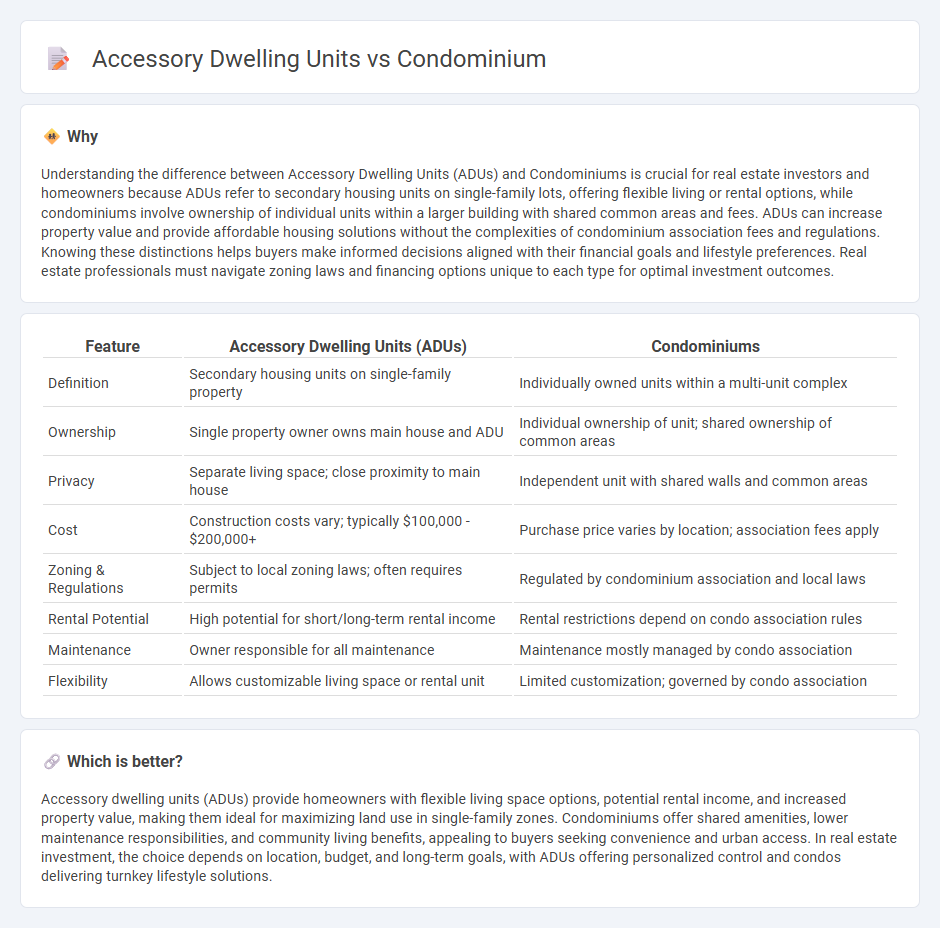
Accessory dwelling units (ADUs) offer flexible living spaces on single-family properties, enhancing property value and providing rental income opportunities. Condominiums provide shared ownership of individual units within a larger building, featuring common amenities and lower maintenance responsibilities. Explore the benefits and differences of ADUs versus condominiums to determine the best real estate investment for your needs.
Why it is important
Understanding the difference between Accessory Dwelling Units (ADUs) and Condominiums is crucial for real estate investors and homeowners because ADUs refer to secondary housing units on single-family lots, offering flexible living or rental options, while condominiums involve ownership of individual units within a larger building with shared common areas and fees. ADUs can increase property value and provide affordable housing solutions without the complexities of condominium association fees and regulations. Knowing these distinctions helps buyers make informed decisions aligned with their financial goals and lifestyle preferences. Real estate professionals must navigate zoning laws and financing options unique to each type for optimal investment outcomes.
Comparison Table
| Feature | Accessory Dwelling Units (ADUs) | Condominiums |
|---|---|---|
| Definition | Secondary housing units on single-family property | Individually owned units within a multi-unit complex |
| Ownership | Single property owner owns main house and ADU | Individual ownership of unit; shared ownership of common areas |
| Privacy | Separate living space; close proximity to main house | Independent unit with shared walls and common areas |
| Cost | Construction costs vary; typically $100,000 - $200,000+ | Purchase price varies by location; association fees apply |
| Zoning & Regulations | Subject to local zoning laws; often requires permits | Regulated by condominium association and local laws |
| Rental Potential | High potential for short/long-term rental income | Rental restrictions depend on condo association rules |
| Maintenance | Owner responsible for all maintenance | Maintenance mostly managed by condo association |
| Flexibility | Allows customizable living space or rental unit | Limited customization; governed by condo association |
Which is better?
Accessory dwelling units (ADUs) provide homeowners with flexible living space options, potential rental income, and increased property value, making them ideal for maximizing land use in single-family zones. Condominiums offer shared amenities, lower maintenance responsibilities, and community living benefits, appealing to buyers seeking convenience and urban access. In real estate investment, the choice depends on location, budget, and long-term goals, with ADUs offering personalized control and condos delivering turnkey lifestyle solutions.
Connection
Accessory dwelling units (ADUs) and condominiums both offer flexible housing solutions that maximize property value and living space in urban real estate markets. ADUs provide an independent living area on a single-family lot, complementing condominium ownership, which involves shared ownership of a multi-unit building. Both structures enhance housing density, affordability, and community diversity, aligning with modern urban development trends.
Key Terms
Ownership Structure
Condominiums provide individual ownership of units within a multi-unit complex, with shared ownership of common areas managed by a homeowners' association. Accessory dwelling units (ADUs) are secondary housing units on a single-family lot that remain under the same ownership as the main residence, often used for rental income or multigenerational living. Explore the nuances of these ownership structures to determine the best fit for your investment or housing needs.
Zoning Regulations
Condominium developments are typically governed by zoning regulations that emphasize land use, density limits, and building height restrictions to maintain urban planning standards. Accessory dwelling units (ADUs) face evolving zoning laws that often encourage their integration to address housing shortages, with specific rules on size, occupancy, and placement. Explore how these zoning distinctions impact property values and urban growth by learning more about local ordinances and planning strategies.
Homeowners Association (HOA)
Condominiums often have Homeowners Associations (HOAs) that enforce strict rules on property maintenance, shared amenities, and resident behavior to maintain uniformity and property values, whereas Accessory Dwelling Units (ADUs) within single-family neighborhoods may face fewer HOA restrictions but still must comply with local zoning regulations. HOAs in condominium communities typically collect fees that cover shared services and repairs, while ADU owners are usually responsible for their own unit's upkeep, potentially reducing ongoing costs but limiting community amenities. Explore the distinct regulatory and financial impacts of HOAs on condominiums and ADUs to make informed housing decisions.
Source and External Links
Condominium | Wex - This webpage provides information on condominiums as a type of residential common interest development where each member owns their unit and shares common areas through a governing association.
What is a condo? - This article defines condominiums as separate residential units owned individually, with shared common areas maintained through homeowners association fees.
What Is A Condo? - This webpage explains condominiums as privately owned units within a community, sharing common areas and amenities managed by a homeowners association.
 dowidth.com
dowidth.com